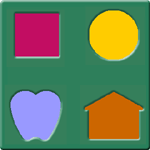LEA 3-D PUZZLE
 The LEA Puzzle is used in training and assessment of both
normal infants and young children as well as of older
children and adult persons with neurologic disorders or
at early developmental levels.
The LEA Puzzle is used in training and assessment of both
normal infants and young children as well as of older
children and adult persons with neurologic disorders or
at early developmental levels.
The aim is to help the child to develop the concept same/different as a prerequisite for measurement of visual acuity. The introduction of the play situation varies depending on the age and cognitive level of the child/person. The very young, 10-11 month-old infants will put the puzzle pieces in their mouth and bang the floor or the table with them.
Give only the square and the round puzzle pieces at this stage and also during the next stage when the child starts to drop or to throw the puzzle pieces, often throwing also the puzzle board. This is a certain phase in the normal development of auditory space, the child is not mean. Since the board is heavy, it may break something if thrown with force so watch the child and rescue the board before it is thrown or catch it in midair.
At the next level the child starts to study the cut-outs of the puzzle and may by chance put the round, orange puzzle piece in the orange cut-out, later the blue square puzzle piece into the blue cut-out. When the child repeats these and starts to do it with obvious intention, let him/her try the apple and house puzzle pieces that require better motor skills than the circle and the square.
When the child can place all four colored pieces in their cut-outs introduce the black and white side starting again with the circle and the square.
You will be able to follow the development of motor skills and reasoning when observing the child playing the LEA Puzzle, can help him/her to develop the concept of pictures representing objects when drawing the pictures of the puzzle pieces, and construct some the first words to depict the puzzle pieces. As an example of what may be observed, a story of a healthy Finnish boy with moderate low vision follows:
Janne received the puzzle as a present from his grandfather the age of 10 months. At that age the only use he found for the puzzle was tasting the puzzle pieces.
Three weeks later he found out that the puzzle pieces could be stacked on each other. He turned the puzzle pieces and the board over and over again and explored the cut-outs with his little fingers. At this stage the puzzle pieces had just the right size for grasping and dropping.
At the age of eleven and a half months Janne started to put the orange circle and the blue square in the correct cut-outs. The other two pieces were quite apparently too demanding and frustrated him so they were kept aside. He started to recognize the white box at the distance and was very proud to be able to open and shut the lid and put all the blocks into the box.
At this same age of eleven and half months Janne started to watch very carefully when an adult drew a line around a puzzle piece to create a picture of the piece, then showed how the puzzle piece could be placed on the picture.
At the age of exactly one year Janne could spend quite a long time in getting the puzzle pieces out from their cut-outs and then putting them back. The circle and the square were placed in their correct cut-outs every time and he clearly preferred playing with them but he was able to place both the house and the apple in their cut-outs although his motor abilities and concentration were stretched to their limits. When all four pieces were in the correct places he made every one in the room aware of how clever and dexterous he was.
A month later, at the age of 13 months Janne started to become interested in the black and white side. Again the circle and the square were the easy ones and the house the most difficult.
When the forms were now drawn on paper he looked at the smaller and smaller forms for long periods of time and then looked at the adult as if asking "what do you try to tell me?". Now and then he pointed on the circle saying "loh" (circle is in Finnish "pallo" = Janne's "loh"). He used also the signs of ball and apple (there is a deaf member in the family so he was accustomed to use signs from early on) and about two weeks later started to use "nah" for apple (apple = omena = Janne's "nah").
When three LEA Playing Cards were put in front of him he quite often could point with his finger on the correct picture when asked "where is the ball" and "where is the TV (= square)". However, it took another three months before he could really concentrate long enough so that binocular visual acuity could be measured.
 |
LEA Puzzle exists as a net version, with which you can assess form perception. |